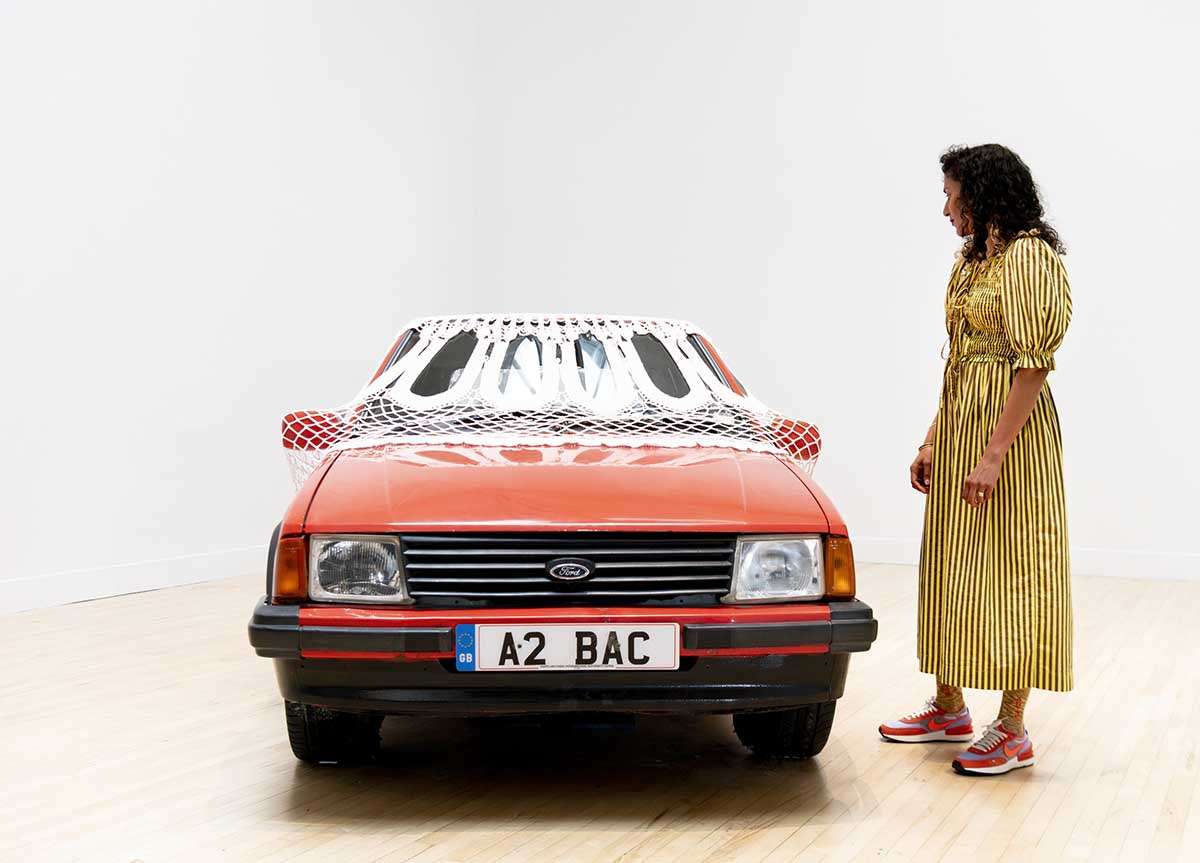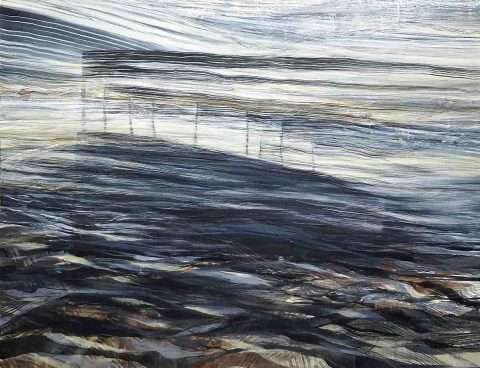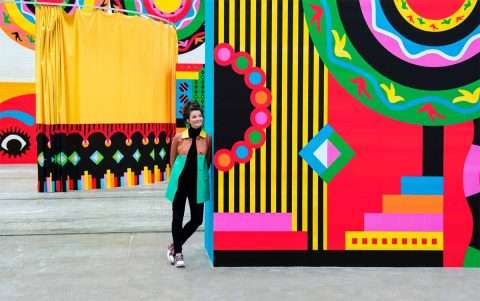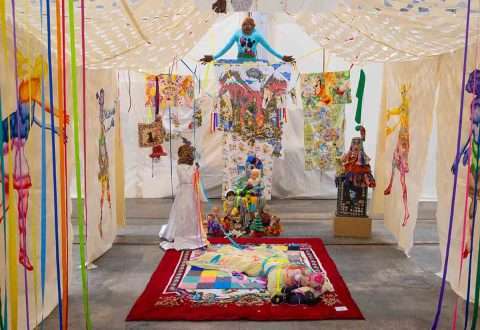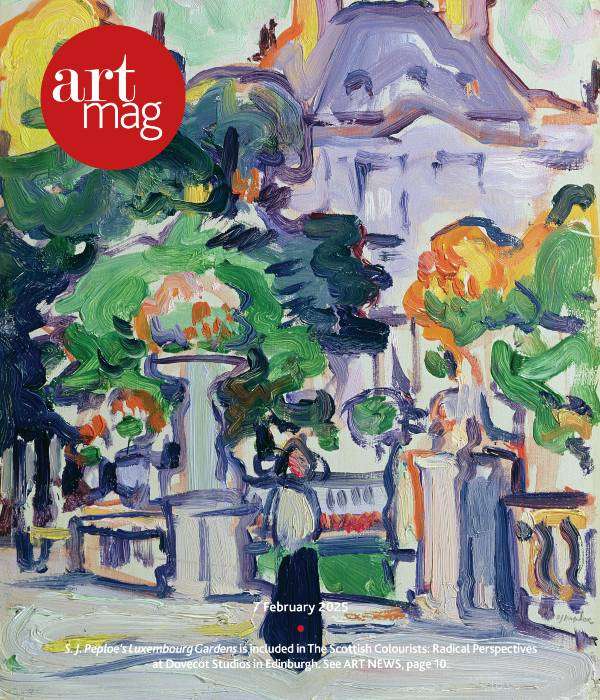Announced on 3rd December, the winner of the 2024 Turner Prize is Jasleen Kaur, whose work appeared on the cover of Artmag’s 10th May issue. Jasleen and Pio Abad are two of this year’s nominees who trained at Glasgow School of Art. The Turner Prize exhibition is showing at Tate Britain in London until 16th February next year, and the 2025 Turner Prize nominees will be displayed at Bradford’s Cartwright Hall Art Gallery from next September, as part of its UK City of Culture programme.
THE fortieth Turner Prize exhibition was unveiled in late September, back at its home in Tate Britain for the first time in six years. However, it has divided critics. Depending on who you read, it’s a death knell for a prize which has been petering out ever since its glory days in the 1990s, or an interesting (if not particularly exciting) snapshot of British contemporary art now.
The biggest and best-known art prize in the UK (the winner gets £25,000, the other nominated artists £10,000 each) has thrived on controversy, but this year there is very little. Media attention and visitor numbers are lower than they were 20 years ago, and the prize has had some trouble attracting high profile sponsors. One writer visiting this year’s show reflected that the prize “seems to have run out of originality and fire”.
In 1984, the prize was set up “to recognise the greatest contribution to British art in the previous 12 months”. The earliest winners tended to be well-established artists, but things changed in 1991 when Channel 4 came on board as media sponsor, the prize money doubled and the age limit of 50 was introduced (it was removed in 2017).

The Young British Artists (YBAs) dominated the prize for the next ten years, with works such as Damien Hirst’s shark in formaldehyde and Tracey Emin’s unmade bed generating seemingly endless newspaper headlines. With controversy came celebrity: winners were announced live on TV by the likes of Madonna and Jude Law.
Those days live long in the memory, making more recent prizes appear dull and dutiful by comparison. In 2019, when the four nominated artists petitioned the judges to share the prize, there were shock waves: was this just another Turner Prize controversy, or a signal that prizes themselves had run their course?
Since the difficult pandemic years, organisers have tried to re-establish the prize as a benchmark for the best of British contemporary art, with or without added glitz and glamour. “It’s really just about the art,” one told me at the launch of the 2022 prize in Tate Liverpool. And, while there will always be disagreements about the make-up of a shortlist, or choice of a winner, perhaps it’s no bad thing that the art itself is the priority.

February 2025 © Tate. Photo Josh Troll
What, then, of the art? First-up this year, in Tate Britain’s well-curated show, is Pio Abad, Manila-born and trained at Glasgow School of Art (Scotland punches above its weight in the Turner Prize, having racked up seven winners and a much longer list of nominees.) Abad’s formative years were spent under the shadow of the Marcos dictatorship, and he is nominated for an exhibition at Oxford’s Ashmolean Museum which take his Filipino history as a starting point for exploring the troubled stories of objects in museum collections.

His show looks and feels like a museum: silence, dim lighting, detailed labels. He excavates stories from the past, like that of Prince Giolo, a heavily-tattooed young Filipino taken to England as a slave in 1691 and exhibited as a curiosity, and has remade, with his wife, jewellery designer Frances Wadsworth Jones, objects from Imelda Marcos’ infamous horde of confiscated jewels. It’s thoughtful and thought-provoking work, based on a great deal of research – however, careful reading of the labels is required to get the full impact.

Next comes Glasgow-born Jasleen Kaur (her first degree is also from GSA, in jewellery design). Her show is a densely-layered reflection on multicultural Britain through the lens of her upbringing in Glasgow’s Sikh community. The stand-out object – if not the poster image for the entire show – is the life-size replica of her father’s Red Ford Escort Mk 3, covered in a giant doily, and pumping out a soundtrack of pop, hip-hop and qawwali music.
The installation – a re-staging of the show she made for Tramway in spring – has a lot of disparate elements: a large carpet, big mechanical hands with prayer bells attached to the fingers, photographs, and a plastic canopy on which various objects from Kaur’s upbringing seem to float. For me, they didn’t pull together enough to tell a coherent story.

Delaine Le Bas covers every inch of her space with painting, fabrics, stitched objects, sound, film and shiny foil. Another subject of a recent Tramway show, she draws on her Roma background, along with an unbridled imagination, politics, mythology and what she describes as a “gypsy-hippy-punk” aesthetic. There’s no shortage of energy in this show, which is, I think, about grief, but it comes at the viewer helter-skelter, ending up (for no reason I could fathom) at the Oracle at Delphi.

It’s something of a relief to emerge into Claudette Johnson’s show, a traditional exhibition of figurative paintings. Johnson, a member of the Black Art movement in the 1980s, paints (or draws – her works are mixed media) large-scale works of black people, often women, claiming for them a place in museums and galleries where they are under-represented. They are beautifully made and evocative, and many critics have tipped her as the favourite to win when the announcement is made on 3rd December.
However, 40 years of Turner Prize history shows us that raw skill is not the only criterion on which the prize is awarded, and nor is majority public opinion. In reality, the field is wide open.
:: Turner Prize 2024 is at Tate Britain until 16 February. www.tate.org.uk

